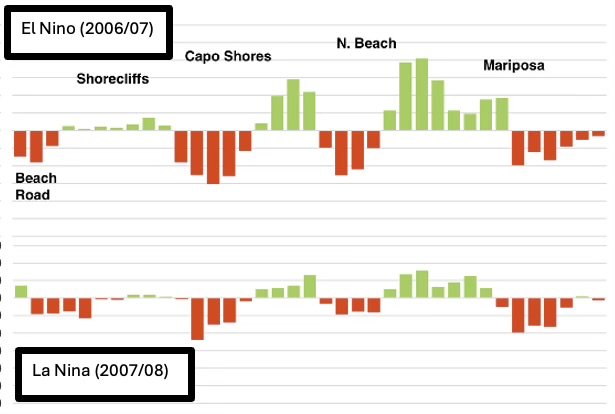Cross-shore sand transport is the process that moves sand perpendicular to the coastline, either onshore or offshore. In Southern California, there is a general seasonal patten to cross-shore transport, with high-energy winter storms tending to erode sand from the beach and move it offshore. Historically, most of that sand piled up just offshore in the form of a nearshore sand bar. The gentler summer swells tend to move that sand back onto the beach.
However, high-energy waves can also hit our coastline during the summer. The waves are generated either by tropical storms, including hurricanes, or by winter storms in the southern hemisphere. Even though these waves travel long distances, they retain high energy and can create huge erosive events on our shoreline.
Cross-shore Transport of Sand
During El Niño winters, Southern San Clemente beaches can lose over 15,000 m3 of sand
Grubbs (2017) studied beach morpho-dynamics and the alongshore and cross-shore transport of sand in San Clemente during an El Nino (winter of 2006/07) and La Nina (winter of 2007/08) periods. She found that the northern and southern portions of the area responded in somewhat different fashions, primarily due to small differences in the orientation of the shoreline.
The study found that both northern and southern beaches lose about 5-6,000 m3 during a "normal" winter. During an El Nino winter, northern San Clemente beaches lost 7,000 m3 and regained almost all of that back the next summer. The southern beaches, however, lost 31,000 m3 and gained back less than half of that in the subsequent summer.
On a more granular level, in northern San Clemente there appear to be smaller "micro-cells" within the San Clemente area, characterized by an erosive north half and a depositional southern half. For example, the northern half of the Capo Shores stretch eroded during the El Nino event, while the southern half apparently received the eroded sediment. Likewise, the northern section of North Beach appears to have eroded and the sediment ended up on its southern end.
The T-Street stretch showed essentially no erosion during the El Nino or La Nina winters; the presence of the offshore reef at this location could potentially protect this stretch of coastline from erosion.
Southern San Clemente did not show any "micro-cells" of erosion and deposition during the El Nino event. There was some accretion at Cottons beach, but not enough to account for the amount of sand lost from State Beach and Cyprus Shores. It is possible that the sand eroded from this stretch was primarily transported offshore.
The La Nina winter in southern San Clemente showed significant erosion in the State Beach area, with slight accretion to the north and south.
The depth of closure is the water depth at which sand transport occurs due to wave action. Depth of closure is primarily related to wave period (wave length) with longer wave periods leading to a greater depth of closure.
Vulis (2022) looked at changes in the depth of closure between 2000-2020. The study found that the average depth of closure is around 3.5m, but that during El Nino events in 2010 and 2016 increased to 4.5m, decreasing to 2.5m during the 2020 La Nina event. What these changes could mean is that during El Nino events, sediment could be transported into deeper water, and that subsequent summer swells, having a shallower depth of closure, could not reactive that sand and bring it back onshore.





